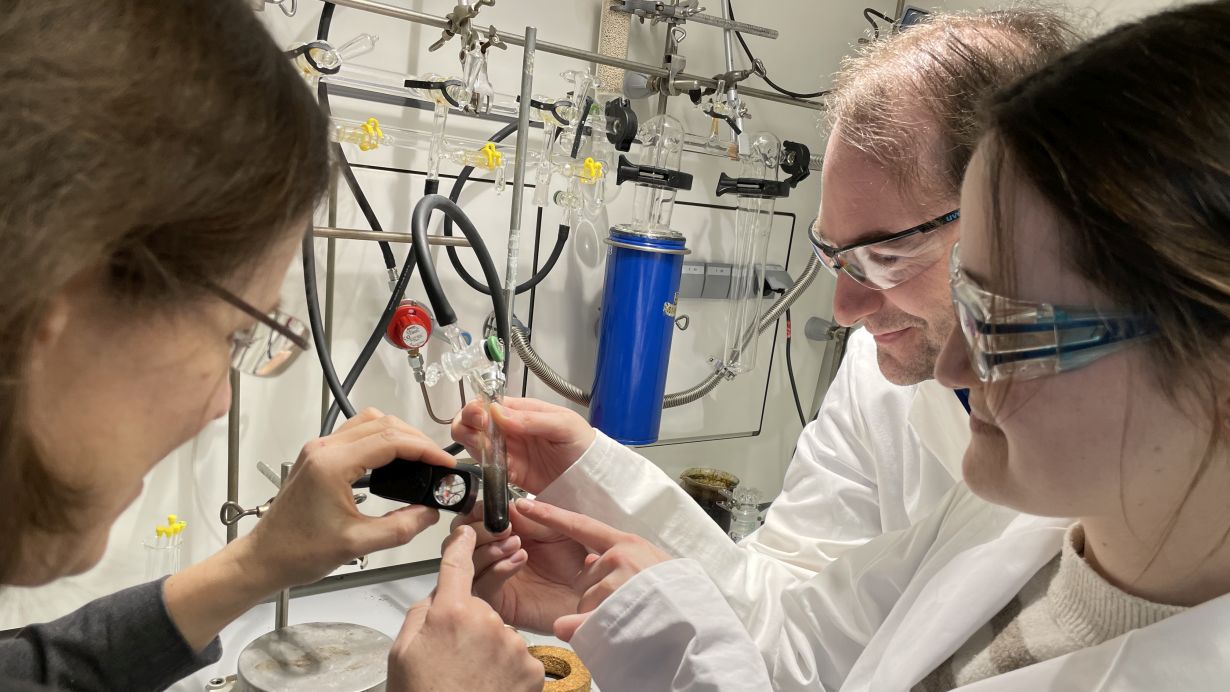
Researchers at the Karlsruhe Institute of Technology (KIT) have synthesized a Bi5--ring, a molecule with five bismuth atoms, and stabilized it in a metal complex. Their discovery fills a gap in chemical knowledge and enables future applications in materials research, catalysis, and electronics. Their findings have been published in Nature Chemistry. ( DOI: 10.1038/s41557-024-01713-8 )
"By synthesizing the Bi5--ring, we've answered a long-standing question of basic research. In the future, this molecule could play an important role in the development of new materials and chemical processes," said Professor Stefanie Dehnen from KIT's Institute for Inorganic Chemistry, where she heads the cluster-based materials research group. According to Dehnen, it is of particular interest that the Bi5⁻-ring has a structure similar to that of the cyclopentadienyl molecule (C5H5)⁻, which has a wide range of industrial applications. However, the Bi5⁻-ring differs with its greater mass and unique electronic properties.
Chemical Puzzle Solved after Decades
For decades, researchers have sought heavy analogues of the cyclopentadienyl ring, i.e. molecules in which the original carbon and hydrogen atoms are replaced by atoms of heavier elements. Such molecules have potentially interesting and attractive properties for catalyzing chemical reactions or for use in materials for electronic components. The analogue with atoms of bismuth (a heavy but non-toxic metallic element) had not been produced previously although the ring was predicted to have aromatic properties, such as a stable distribution of electrons, similar to those of (C5H5)⁻. The successful isolation of the ring shows that even the heaviest variants can be integrated in stable compounds and used in chemical reactions. High-precision analytical methods, applied in collaboration with groups headed by Professor Florian Weigend from the Institute for Quantum Materials and Technologies (IQMT) and Professor Wolfgang Wernsdorfer from the Physikalisches Institut at KIT, provided detailed insights into the special electronic and magnetic characteristics of the product [{IMesCo}2Bi5]. As expected, the results demonstrated that this molecule is particularly promising for applications in catalysis and electronics.
Dehnen and her team achieved the synthesis with a combination of experience, intuition and modern synthesis techniques. According to Dehnen, a recent recipient of the IUPAC Award for Distinguished Women in Chemistry or Chemical Engineering, a crucial factor was the use of a special solvent.
Sustainable Technologies Could Benefit
The research group's work demonstrates the importance of basic research is for scientific breakthroughs. Not only are the results a milestone in chemistry, they could also provide a foundation for the development of more efficient and environmentally friendly technologies. The project received funding from the German Research Foundation and the European Research Council. The team intends to investigate further compounds based on the Bi5⁻-ring to fully exploit its potential for chemical reactions and materials science applications. Plans also include the use of machine learning methods to accelerate research and further improve synthesis pathways. "We hope our work will encourage other researchers to continue along this route and develop new applications," Dehnen said. She and her team also aim to work with interested companies and research institutions. (mgr)
Original publication
Julia Rienmüller, Benjamin Peerless, Sagar Paul, Florian Bruder, Wolfgang Wernsdorfer, Florian Weigend and Stefanie Dehnen: Isolation of a planar π-aromatic Bi5-ring in a cobalt-based inverse-sandwich-type complex. Nature Chemistry. DOI: 10.1038/s41557-024-01713-8
More about the KIT Materials Center
Being "The Research University in the Helmholtz Association", KIT creates and imparts knowledge for the society and the environment. It is the objective to make significant contributions to the global challenges in the fields of energy, mobility, and information. For this, about 10,000 employees cooperate in a broad range of disciplines in natural sciences, engineering sciences, economics, and the humanities and social sciences. KIT prepares its 22,800 students for responsible tasks in society, industry, and science by offering research-based study programs. Innovation efforts at KIT build a bridge between important scientific findings and their application for the benefit of society, economic prosperity, and the preservation of our natural basis of life. KIT is one of the German universities of excellence.






